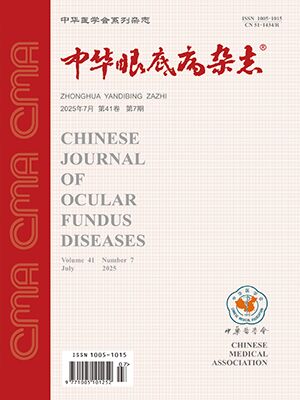| 1. |
Tang Y, Wang X, Wang J, et al. Prevalence and causes of visual impairment in a Chinese adult population: the Taizhou eye study[J]. Ophthalmology, 2015, 122(7): 1480-1488. DOI: 10.1016/j.ophtha.2015.03.022.
|
| 2. |
Ohno-Matsui K, Kawasaki R, Jonas JB, et al. International photographic classification and grading system for myopic maculopathy[J]. Am J Ophthalmol, 2015, 159: 877-883. DOI: 10.1016/j.ajo.2015.01.022.
|
| 3. |
Ruiz-Medrano J, Montero JA, Flores-Moreno I, et al. Myopic maculopathy: current status and proposal for a new classification and grading system (ATN)[J]. Prog Retin Eye Res, 2019, 69: 80-115. DOI: 10.1016/j.preteyeres.2018.10.005.
|
| 4. |
Ruiz-Medrano J, Flores-Moreno I, Ohno-Matsui K, et al. Validation of the recently developed ATN classification and grading system for myopic maculopathy[J]. Retina, 2020, 40(11): 2113-2118. DOI: 10.1097/IAE.0000000000002725.
|
| 5. |
Chen Q, He J, Hu G, et al. Morphological characteristics and risk factors of myopic maculopathy in an older high myopia population-based on the new classification system (ATN)[J]. Am J Ophthalmol, 2019, 208: 356-366. DOI: 10.1016/j.ajo.2019.07.010.
|
| 6. |
Wong CW, Phua V, Lee SY, et al. Is choroidal or scleral thickness related to myopic macular degeneration?[J]. Invest Ophthalmol Vis Sci, 2017, 58(2): 907-913. DOI: 10.1167/iovs.16-20742.
|
| 7. |
Viera AJ, Garrett JM. Understanding interobserver agreement: the kappa statistic[J]. Fam Med, 2005, 37(5): 360-363.
|
| 8. |
Ye L, Chen Q, Hu G, et al. Distribution and association of visual impairment with myopic maculopathy across age groups among highly myopic eyes-based on the new classification system (ATN)[J]. Acta Ophthalmol, 2022, 100(4): 957-967. DOI: 10.1111/aos.15020.
|
| 9. |
Lin C, Li SM, Ohno-Matsui K, et al. Five-year incidence and progression of myopic maculopathy in a rural Chinese adult population: the Handan eye study[J]. Ophthalmic Physiol Opt, 2018, 38(3): 337-345. DOI: 10.1111/opo.12456.
|
| 10. |
Yan YN, Wang YX, Yang Y, et al. Ten-year progression of myopic maculopathy: the Beijing eye study 2001-2011[J]. Ophthalmology, 2018, 125(8): 1253-1263. DOI: 10.1016/j.ophtha.2018.01.035.
|
| 11. |
Fang Y, Yokoi T, Nagaoka N, et al. Progression of myopic maculopathy during 18-year follow-up[J]. Ophthalmology, 2018, 125(6): 863-877. DOI: 10.1016/j.ophtha.2017.12.005.
|
| 12. |
Zhang RR, Yu Y, Hou YF, et al. Intra- and interobserver concordance of a new classification system for myopic maculopathy[J]. BMC Ophthalmol, 2021, 21(1): 187. DOI: 10.1186/s12886-021-01940-4.
|
| 13. |
Tian J, Qi Y, Lin C, et al. The association in myopic tractional maculopathy with myopic atrophy maculopathy[J/OL]. Front Med (Lausanne), 2021, 8: 679192[2021-08-20]. https://pubmed.ncbi.nlm.nih.gov/34490288/. DOI: 10.3389/fmed.2021.679192.
|
| 14. |
Matsumura S, Sabanayagam C, Wong CW, et al. Characteristics of myopic traction maculopathy in myopic Singaporean adults[J]. Br J Ophthalmol, 2021, 105(4): 531-537. DOI: 10.1136/bjophthalmol-2020-316182.
|
| 15. |
Fang Y, Du R, Nagaoka N, et al. OCT-based diagnostic criteria for different stages of myopic maculopathy[J]. Ophthalmology, 2019, 126(7): 1018-1032. DOI: 10.1016/j.ophtha.2019.01.012.
|
| 16. |
dell'Omo R, Virgili G, Bottoni F, et al. Lamellar macular holes in the eyes with pathological myopia[J]. Graefe's Arch Clin Exp Ophthalmol, 2018, 256(7): 1281-1290. DOI: 10.1007/s00417-018-3995-8.
|
| 17. |
Hemelings R, Elen B, Blaschko MB, et al. Pathological myopia classification with simultaneous lesion segmentation using deep learning[J/OL]. Comput Methods Programs Biomed, 2021, 199: 105920[2020-12-28]. https://pubmed.ncbi.nlm.nih.gov/33412285/. DOI: 10.1016/j.cmpb.2020.105920.
|
| 18. |
Shao L, Zhang QL, Long TF, et al. Quantitative assessment of fundus tessellated density and associated factors in fundus images using artificial intelligence[J]. Transl Vis Sci Technol, 2021, 10(9): 23. DOI: 10.1167/tvst.10.9.23.
|




